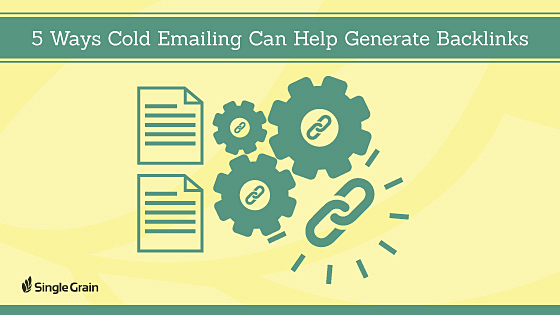
By Chris Bibey
SEO is anything but a “one size fits all” strategy. What works for one website may not work for another. And what worked for you in the past may not yield the same results in the future.
From startup companies to enterprise websites, SEO is critical. Taking this one step further, there is nothing more important than high-quality inbound links.
But here is the million dollar question: what is the best way to build backlinks without drawing the ire of Google?
While there are many strategies to employ, such as content marketing, inbound marketing, social media marketing, and influencer marketing, there is one tactic you might be overlooking.
Cold e-mailing. Yes, you read that right. Sending cold e-mails is one of the best ways to generate backlinks. The response rate may not knock your socks off, but as this study shows, an open rate of nearly 50% is possible.
Here are five examples of cold e-mails that will get you closer to the 50-percent open rate:
1. Introduce Yourself
This does not typically generate immediate results, but it is the first step in building a strong relationship that will eventually payoff.
Try this example:
Dear [name],
I wanted to send you a quick note of introduction. As a marketing professional, I love what you are doing with your website, [website].com.
Being that we work in the same industry, I was hoping to connect via e-mail and stay in touch.
If there is ever anything I can do for you, feel free to reach out. And as always, I will continue to read your blog and stay current with your business.
Thanks,
[your name]
You aren’t asking for a backlink. You don’t even allude to the fact that you have a website. This is nothing more than a basic introduction on which you can build off of in the future.
It may be the “long way home,” but it’s also one of the best methods of networking with the idea of eventually reaching the intended result.

2. Send a Link to Your Best Blog Post
Maybe the recipient is familiar with your blog. But maybe he or she doesn’t even know it exists. Why take the risk?
With this approach, send a link to your best blog post and let the content do the speaking. Try this on for size:
Dear [name],
As I’m sure you’re quite busy, I’ll be quick. I am a big fan of your company, and wanted to share some of my work with you.
Recently, I published a blog post entitled [blog post name]. In it, I discuss a variety of strategies for [the topic].
If you have a minute, I would love for you to read the post and let me know your thoughts. It is always nice to receive feedback from somebody with as much industry experience as yourself.
Thanks again for your time.
[your name]
It’s a bit more direct than the first template, so your goal (and hope!) is that the person reads the post and likes it enough to do one of two things:
- Add your blog to their regular reading list
- Link back to this particular post, or another, in the near future
You can’t guarantee that this will generate a backlink, but it’s definitely a step in the right direction. If nothing else, the person is now aware of your blog. At that point, it’s up to your content to do the selling.
3. Tell Them About a Recent Mention
Moving forward, this strategy is a bit more direct than #2. Here is how it works:
- Publish a blog post in which you mention a particular company (or maybe several).
- Reach out to the appropriate party, via e-mail, to let them know about the link.
There is a fine line between being helpful and sending spam. You need to know where to draw the line. Here is an example that you can customize to fit your needs:
Dear [name],
As a fan of your brand, I recently mentioned your company in a blog post entitled [blog post name]. Not only do I love what your company has to offer, but I am positive that my readers will feel the same way.
If you have any time, it would be an honor for you to read the post and provide your thoughts. It’s always helpful to hear from people in your position.
Once again, thanks for everything you do. I hope my recent post sends some qualified traffic to your website.
Hope to hear from you soon.
[your name]
This is a big step forward and is getting you even closer to directly asking for a backlink.
The primary advantage of this strategy is that you have already proven to the recipient that you respect their company. What this person doesn’t know is that you published the link, to a certain degree, in an attempt to generate the same response in the future.
If you are lucky, this approach will result in traffic to your site and an eventual backlink.
4. Suggest Where Your Website Fits In
Do you have reason to believe that your website should be included on a specific resource page? Do you believe that your content could be of great assistance to a particular audience?
There is nothing wrong with reaching out to others and suggesting where your website fits in. Let’s take a closer look at how this can be done:
Dear [name],
I recently came across your resource page that lists all the best marketing tools for 2016. I love every tool on the list, especially [favorite tool] and [favorite tool]. Both of these are used by my team on a regular basis.
I am hoping you will consider adding another tool to the list – [your company’s tool]. My company has developed this tool to help marketing professionals work in a more efficient manner.
If you have time to review the tool, need access, or simply have questions, feel free to reach out. I would be happy to provide you with more information.
Thank you for your consideration.
[your name]
This takes all the guesswork out of the equation. You are giving the person a clear idea as to how they can link back to your website. Now it’s up to them to decide if this is the right decision.
5. Just Ask
If all else fails and you don’t want to beat around the bush, it may be time to take the direct approach. This is when you e-mail a specific person who can provide a super valuable link, and simply say what’s on your mind.
This is easier said than done, as you don’t want to come across as yet another spammer. This e-mail template will help increase your conversion rate:
Dear [name],
I know that you are very busy. I also know that you receive a lot of e-mail. So I’ll be quick.
My blog [blog title] chronicles a variety of subjects, many of which are related to your business. The reason I am e-mailing you is simple: I hope that in the future, when applicable, you will consider linking to my website or one of my hundreds of blog posts.
Yes this will help drive traffic to my website, but just as importantly, I think the information will be useful to your audience.
Of course, if you have any questions, please let me know. I would love to provide more information and stay in touch in the future.
Thank you for your time.
[your name]
This is just about as direct as you can get without going overboard. Here is the most important part of the e-mail:
“Yes this will help drive traffic to my website, but just as importantly, I think the information will be useful to your audience.”
With this, you are showing that you aren’t looking for a handout. As long as your content backs up your claim, as long as it truly provides value, you have a good chance of the person providing a backlink down the road.

Photo Credit: vipdestiny via Compfight cc
Track Your Actions and Results
You are now armed with the knowledge necessary to build backlinks via cold e-mailing. This will always be a hit or miss technique, so it’s important to play the numbers game. The more e-mails you send, the greater chance you have of success.
It can be time consuming to send one e-mail after the next, but if you want to build high-quality links you need to outwork the competition. In addition, it’s critical to track your actions and results. Here’s a simple way to do that:
- Create a spreadsheet detailing every e-mail you send (if you’re using the examples from this blog post, you might want to title them “e-mail #1,” “e-mail #2,” etc.), including the recipient’s name, company, e-mail address, date sent, and a column for responses.
- Make note of all responses, both positive and negative.
- Pay close attention to positive responses, especially from those who immediately link back to your website.
By tracking your actions and results, you can prevent double-sending to the same recipient. You can also get a better idea as to which e-mail template generates the best results, as well as which types of people are most responsive to your message.
Conclusion
For sales professionals, cold calling remains a viable strategy for generating leads. But link building is a different game entirely.
If you are seeking a unique approach to building backlinks, consider cold e-mailing. It just might be the change you need in order to reach all your SEO-related goals.
With 78% of decision makers saying that they have agreed to a meeting or attended an event as the result of a cold e-mail or a cold call, the proof is in the pudding. Business professionals will read your e-mail. You just need to take the right approach.
Do you have any experience with cold e-mailing as a way of building links? What were the results?



